For Super Sleuth DC Fans: An ongoing look at 86 years of DC Comics, beginning with New Fun #1, January 11, 1935 through March 1938.
More Fun #9 appeared on newsstands on March 5, 1936, 85 years ago with a March/April cover. The cover in dark blue featured a 4-panel comic by Vin Sullivan and was the last time a comic was featured on the cover of More Fun. Sullivan’s character Charlie Fish slips on a roller skate and ends up crashing into a pole and sees birdies. He tells us “Gosh! Spring is here Already!” The SM distribution mark is in the corner and the comic is 10 cents. At the bottom we’re told it’s “All Original…All New!! Mystery! Adventure! Thrills!!”

This comic is rare and the only copies I have access to are poor digital copies although I was able to get a few pages from collectors. It was difficult to read and I may have missed some clues here and there. The magazine in this state doesn’t lend itself well to images so unfortunately most of the images contained in this post aren’t the best.
My overall sense from going through More Fun #9 is that it lacked MWN’s precise editorial hand and the editorial comments don’t have the essence of his voice as they do in the other magazines. Comics historians who are not familiar with the Major, his life or his other writings miss some of the underlying context to the comics. As a result of his military schooling and years in the military, the Major was disciplined, organized and intuitively had a good esthetic eye. I’m wondering if Vin Sullivan had the overall responsibility for getting this magazine out. He did the cover and a Spike Spalding story but his usual 2 or 3 additional comics and fillers are not in this magazine. If not Sullivan then it may have been Ellsworth or both of them.
Besides the possible lack of the Major’s tight control there are the other background events that we do know occurred during this time period. If these comics were being put together in December 1935 that is around the time given that Cook and Mahon left the Major’s company to start their own comics magazine—The Comics Magazine. More Fun #9 appeared on newsstands March 5 and New Comics #4 came out just 10 days later on March 15. My guess is that MWN was working to get New Comics #4 out before Cook and Mahon’s appearance of The Comics Magazine #1 on March 20.
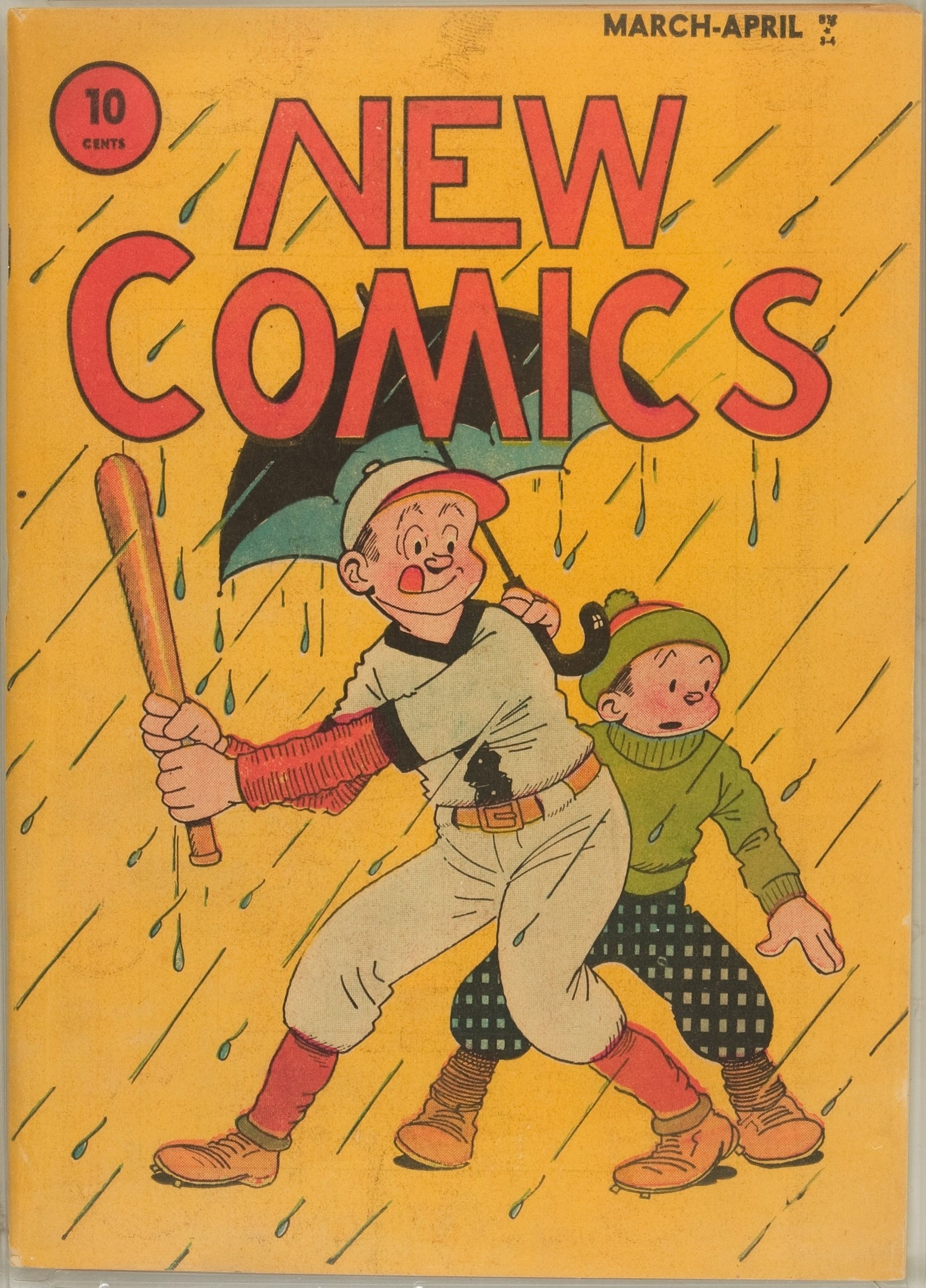
New Comics #4 is the usual precise and carefully put together magazine and I’ll go into that in the next post. I’m willing to bet the Major was focused on that issue because it contained some of the same artists and comics that would appear 5 days later in Cook and Mahon’s The Comics Magazine. The Major’s highly competitive nature—years of playing polo and military maneuvers and action would lead to his desire to beat the competition to the newsstand whatever the unusual situation that caused this odd event. All these aspects taken together point to the possibility that either Sullivan or Whitney or both were taking the lead on More Fun #9.
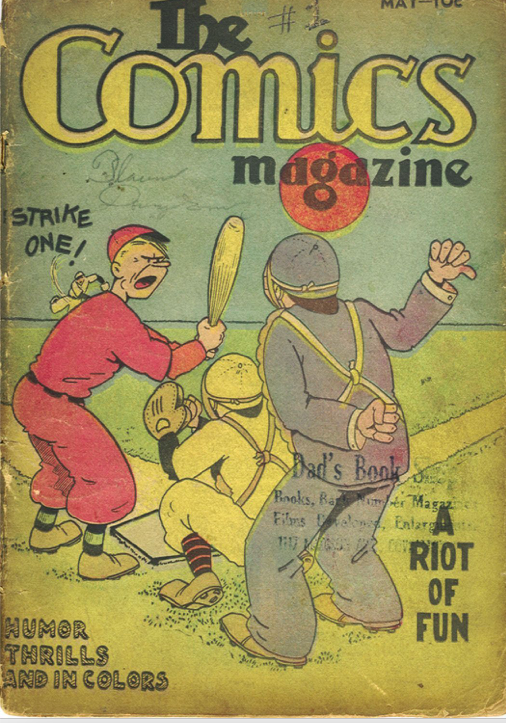
The inside cover masthead no longer has William H. Cook as Managing Editor or John F. Mahon as Business Manager. Malcolm Wheeler-Nicholson is listed as Editor and Publisher with Associate Editors–Vincent A. Sullivan and Whitney Ellsworth. The National Comics Magazine is above. Note that New Comics is titled as the International Picture Story Magazine. I’m not sure why the distinction.

The indicia is mostly the same as More Fun #8 although instead of More Fun Magazine, Inc. it is listed as published monthly by More Fun, Inc. however the copyright is still listed as More Fun Magazine, Inc. William J. Delaney, Inc. is again listed as the Eastern representative for advertising but there is almost no advertising in this magazine. Remington Typewriters has a full-page ad on the back cover but the usual ads appearing on the inside front and back covers are absent. Is it possible that Delaney and others were pushing the Major to drop More Fun? If so, you can bet the answer to that was a resounding no.
Max Miehl has a recurring small ad for buying coins and there is a tiny ad for a repeating slingshot from a company in Toledo, Ohio that I cannot make out. And that’s it for the paying ads.
A large promotional ad for the upcoming New Comics #4 is on the inside cover beneath the indicia as shown above. It’s in black and white with a red border and similar to the cover that appears on Cook and Mahon’s first issue of The Comics Magazine. Although unsigned it’s clearly by Whitney Ellsworth. Supposedly Vin Sullivan drew the cover for The Comics Magazine. Did he spill the beans and the Major attempt to one up Cook and Mahon? It’s an intriguing mystery.
There are three, possibly four additional promotional pieces in the magazine. The Treasure Hunt Contest takes up a full page. It began in New Fun #3 and appears for the final time as planned. The Fun gnome by Richard Loederer continues to illustrate and W.C. Brigham continues to draw the cartoons. The content seems to be the same.
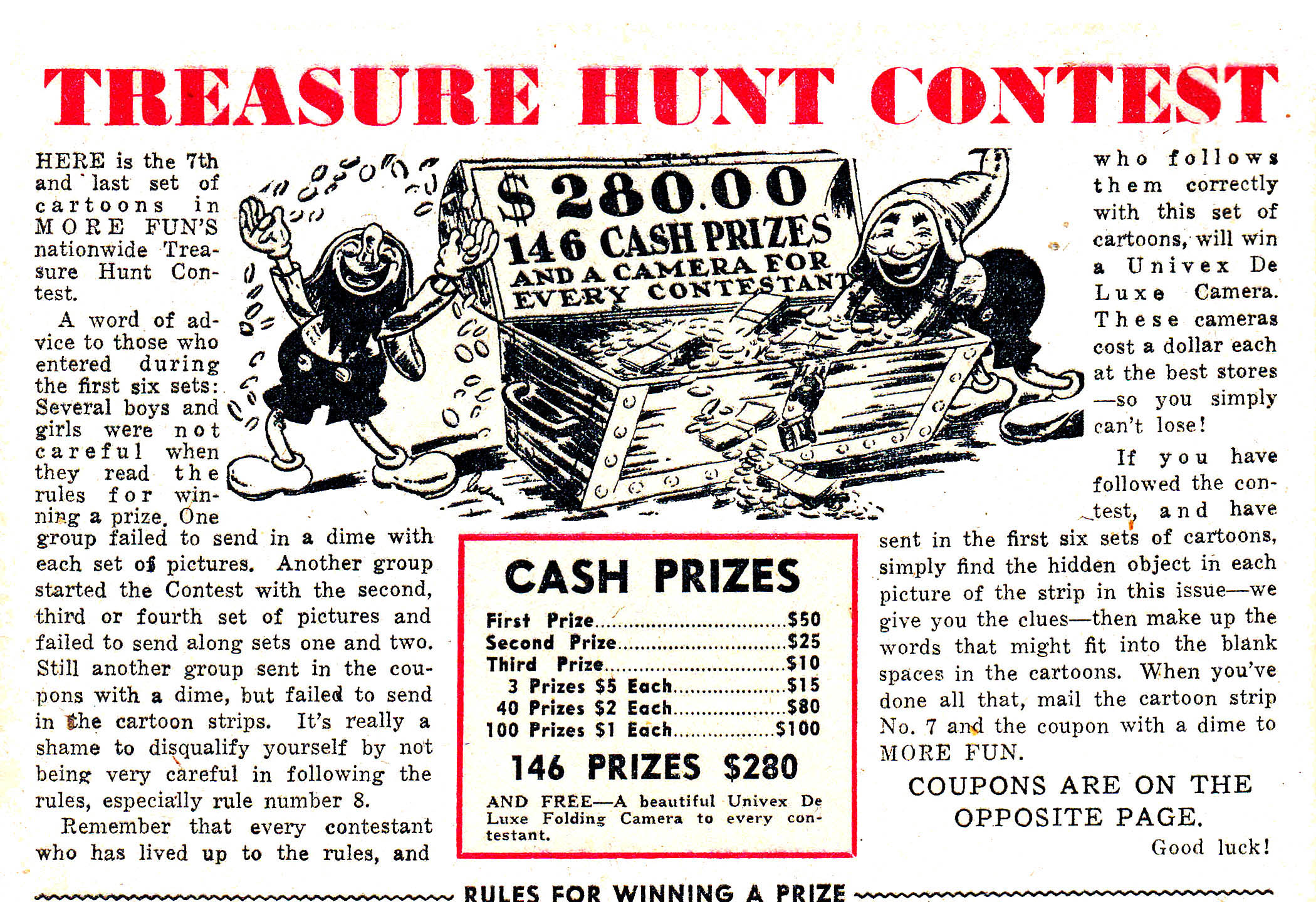
Button, Button, Have you Got Your Button? takes up half a page with an application for the Fun Club. The Dick Loederer Fun gnome illustrates. Jolly Bill continues to urge kids to join for a dime. The secret code for this month is “Don” with the answer “Drake,” the main character from “Don Drake on the Planet Saro.” We’re told that–You’re not a Fun-Club member unless you wear the Button! The second half of the page has the Treasure Hunt coupon and clues and also costs a dime to enter the contest.
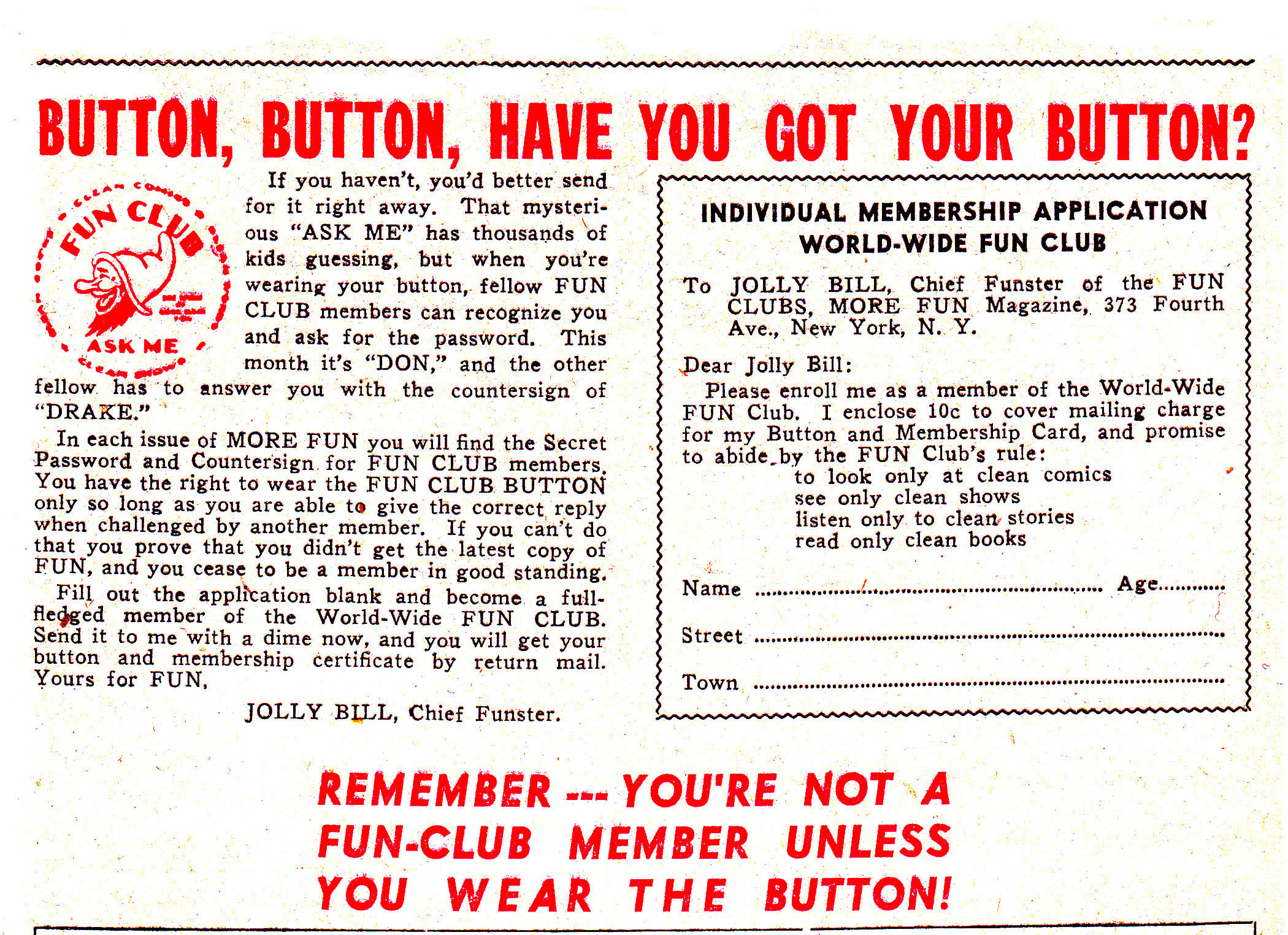
Aunt Marianne, the second of the Major and Elsa’s children, told me she remembered sitting around their kitchen table opening envelopes from kids with “quarters,” then putting buttons into envelopes and walking to the post office with MWN to send out. She called them Superman buttons but obviously that’s not what they were. Aunt Marianne would have been about 12 years old in 1936.
Write a letter and win $5.00 takes up half a page. Readers are asked to—“Write a short letter telling us which is your favorite of all the features in MORE FUN, and WHY it is your favorite.” Then the readers are asked to list ten of their favorites. The best letter will receive $5.00, the second $3.00 and the third $1.00. Most of the second half of the page is a “BIG PREMIUM OFFER” to be a subscriber. Each subscriber receives “a Jumbo Assortment of Surprises.”
The inside back cover is blank on the digital copies I have and GCD (Grand Comics Database) doesn’t list it either. One of my trusted sources did some fancy technical fooling around and it also appears to be a promotion for New Comics possibly without an illustration.
The first page—the Editors’ page–has a hobo holding the editors’ note to readers. It is unsigned and GCD has a question mark after Vin Sullivan’s name. It’s pretty clear it’s a Whitney Ellsworth drawing. If you look at the hobo’s hands and the hands on the inside cover of the ad for New Comics #4 (seen above) plus the eyebrows on all the characters–they are exactly the same. We’re told about the new size which is standard comic book size—8” by 10” that is “smaller, handier.” And “Everything between these two covers is BRAND NEW never before published.”
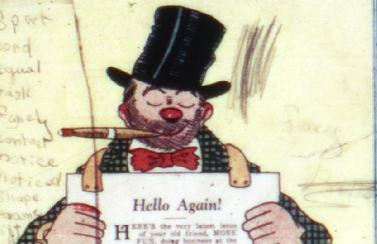
More Fun #9 retains much of its look and content with most of the recurring comics although several of the regular contributors have one comic instead of two or three. John Patterson’s “Skipper Hicks” is gone, having skipped over to Cook and Mahon’s magazine as Skipper Ham Shanks. “Oswald the Rabbit” by Al Stahl disappeared after More Fun #7. Some of the regular feature articles are also absent discussed below in a later paragraph. My comments don’t include the comics or features from the New Comics magazine series. I’ll get into that in the next post.
Our woman on the case, “Sandra of the Secret Service” continued to be drawn by W. C. Brigham (whom I have declared to be William Clarence Brigham, Jr. as opposed to Walter Cole Brigham) retains her hold on prime real estate as the first comic in the magazine. It is two pages in color. In the continuing story of the Gavonian difficulties, Sandra agrees to impersonate Queen Yolanda. Count Tauru has threatened to kill Lothar and Reynolds if she doesn’t. Sandra agrees to go to the ball as Queen Yolanda and the country rejoices to see their queen. However, she receives a message that someone knows she is an imposter and tells her to meet them at the black tower to explain or she will be exposed.
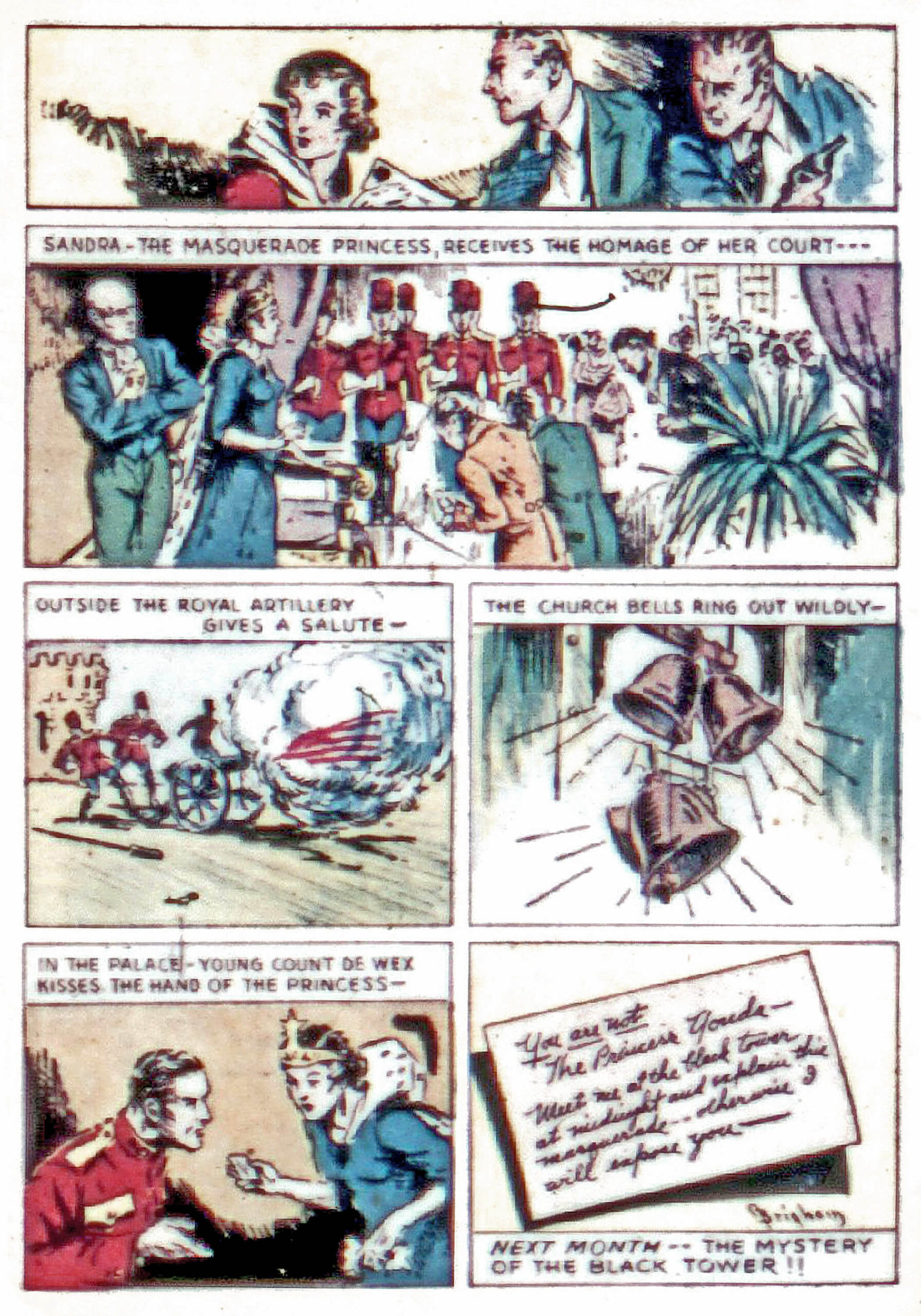
Brigham continued to illustrate the ongoing story of “Jack Woods.” It’s two pages in black and white. We left Dolores and her father hiding in the cave. They have no water and her father is not well. Jack meanwhile has fooled Pancho Villa and his men into thinking he has been swept away in the river. He rides to rescue Delores and her father while Villa and his men also head toward the cave. Will he make it in time? I can’t help but notice that Dolores looks very much like Sandra.

Tom Cooper continues with all four of his features. “Along the Main Line” featuring the recurring characters Jake and Ed with two pages in color. Usually they have a single story complete in each magazine but in this issue, we have a new continuing story. Jake and Ed on The Express (train), which appears to be a freight train, is traveling through a snow storm. They don’t receive the all clear from the station master and stop the train. A “mysterious stranger” holds them up. He has knocked out the station manager and has them send a message through for another train that will wreck the Express. The language is Hollywood gangster talk and the artwork is somewhat unrefined although it may be the quality of the copy. I tend to think the simpler stories are ones Tom Cooper wrote himself and this story may be one of MWN’s pulp type suggestions. We’ll see.
Cooper as MacFergus continues “In The Wake of the Wander” with two pages in color. It is a continuing story and has a similar plot line to a pulp of the Major’s, “The Spanish Doubloons.” Captain Grim jumps from the burning building and lands on top of a stranger. Grim follows the stranger and sees the natives take him prisoner. On his way back, he finds another person dead from the death that leaves no mark. It’s an odd encounter as the dialogue doesn’t quite make sense with what is happening in the illustrations. There’s no clue as to who the stranger is, where he came from and how he figures into the plot. Cooper may have done the artwork but it’s possible someone else may have created the dialogue. This is one of the editorial lapses that I noticed and wondered why MWN let it pass.
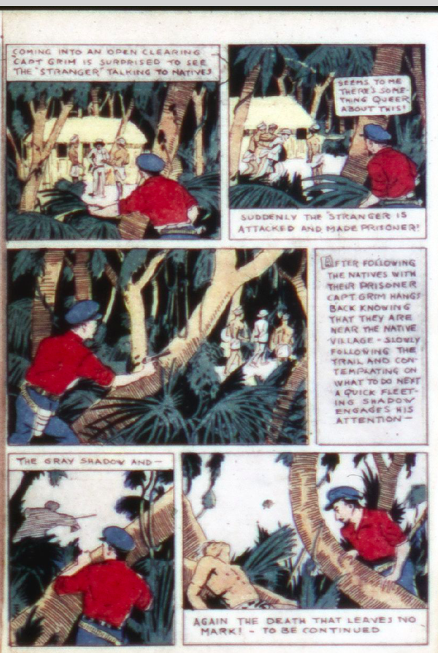
Cooper’s “Buckskin Jim” returns in a recurring story with two pages in black and white. In the last episode Jim was being attacked by a mountain lion. The rope that he is using to climb down the canyon breaks and he and the mountain lion fall into the river. Jim starts to swim for shore and is saved by a person in a canoe. Somehow, he knows Jim’s name. To be continued.
“Midshipman Dewey” originally by Adolphe Barreaux, then taken over by Richard Loederer and now in Tom Cooper’s hands beginning in More Fun #7 continues with two pages in color. The captain hasn’t been captured by the pirates and doesn’t seem to realize what’s going on. He finds Dewey who tells him what has happened. The pirates find the captain and he is now their prisoner. They head the ship toward a group of islands and Midshipman Dewey escapes. It’s an okay story but the artwork is solid.
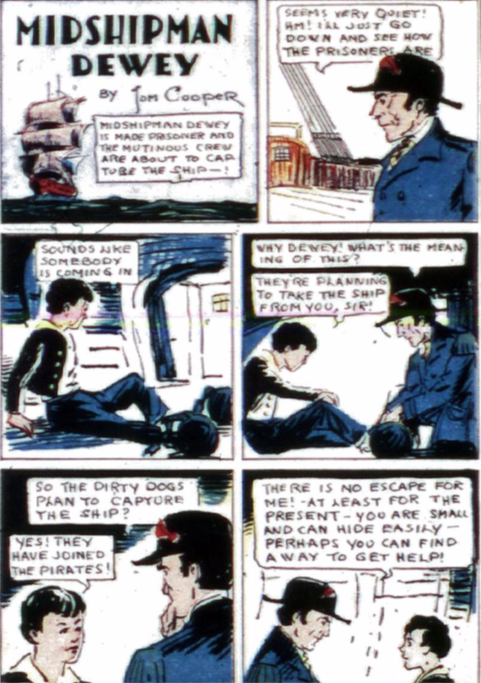
Vincent Sullivan’s “Spike Spalding” continues with two pages in color. Spike and Pincus are on board the ship and Spike sends Pincus to scout to see if he can find out what is going on. Pincus overhears the bad guys talking about Patrania. Although Pincus speaks in stereotypical Black dialect, he is sophisticated enough to know that Patrania is a country in Europe. Just as he goes to tell Spike, he is caught by a rough looking sailor. It’s too bad that Pincus is depicted in a derogatory manner because he is the more interesting character in the comic.
Sullivan also had the obligatory prose piece, “King High” told in 5 pages. The illustration appears to be unsigned and the entire story was really difficult to read until I got clear pages from a collector. The story is simple but interesting enough to follow. Antonio, King of Provokia–yes, you read that right–has to escape first to Naples and then to America because the Grand Duke has plotted against him. The Grand Duke is upset that Antonio won’t marry his somewhat unattractive daughter. Antonio is a talented singer and disguised as “Tony” ends up working in restaurants singing and waiting on tables. Sullivan exhibits the standard attitude towards women in his stories as in his description of the ladies of Provokia listening to the King sing. “This is very odd because those dolls should be milking the cows or be in the market place buying grub for the stronger sex.”
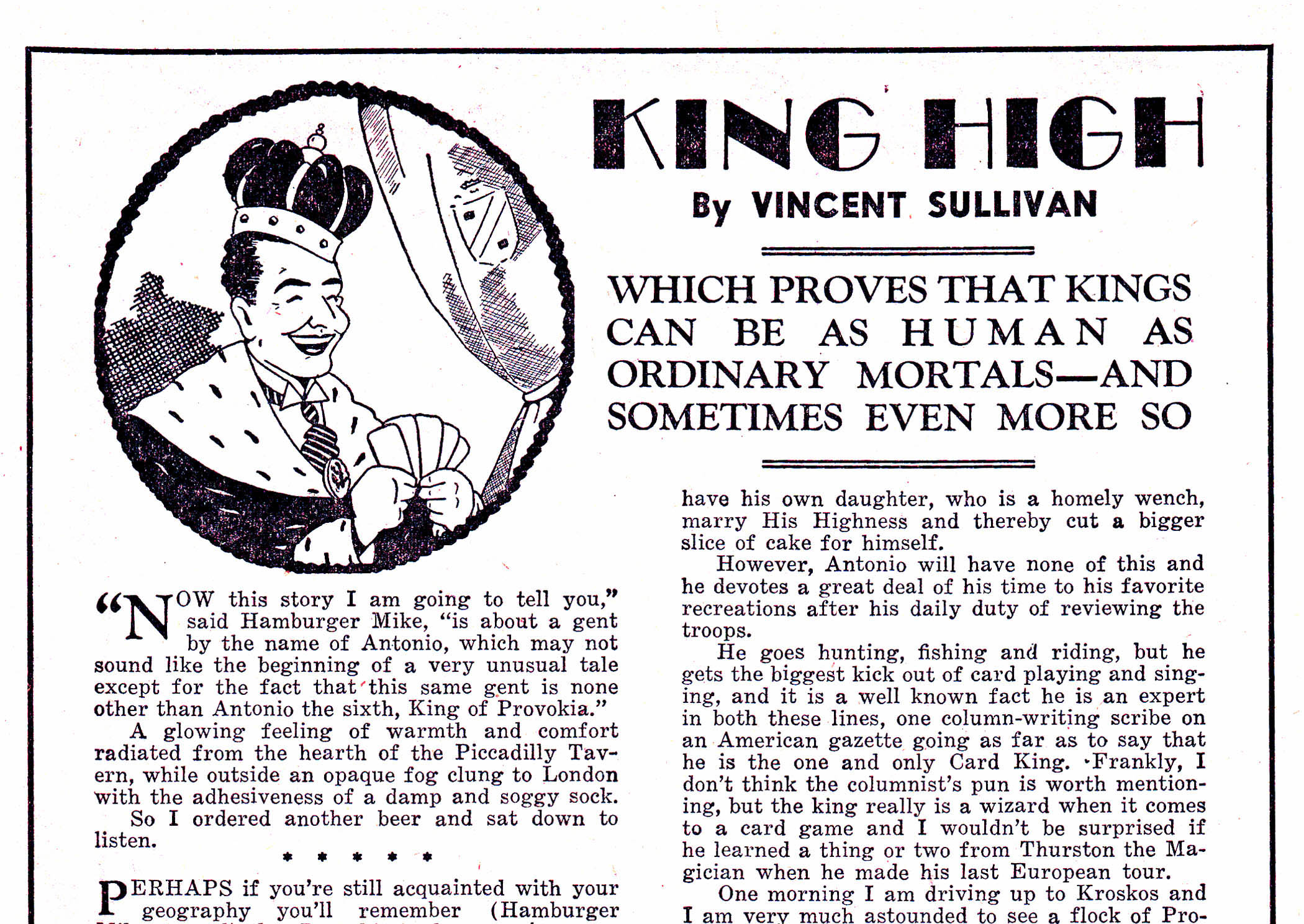
In Naples, Antonio meets Eileen, an American woman who is a reporter at the Morning Globe and when he makes his way to America, they meet again. She asks him to entertain at the Morning Globe’s party. He does such a good job that he is invited to sing on a radio show by Lawlor, the radio director of the Morning Globe. Lawlor invites him to a party where he outplays the gangster Chico the Turk at cards. It seems Antonio is also an excellent card sharp. H. T. Ackerman, the President of General Brands Corporation is so happy to see someone finally beat Chico the Turk that he offers Tony a contract for a radio show. Meanwhile through a mix-up that is not Tony’s fault, Eileen, has been waiting for him at the restaurant where he sings. Tony sings to her over the radio and she forgives him. Guiseppe, Tony’s righthand man finds out that the revolution in Provokia is over and the people want the king back. Tony dreams up a plot to stay in America. He suggests to Chico the Turk that he has a prize beyond any money possible. They play cards and he allows Chico the Turk to win and proceeds to give him his kingship to Provokia. Everyone ends up happily ever after. Although it’s well written, it’s not a sophisticated story. Like Sullivan’s story “Wheels go Round” it would be better as a comic.
Whit Ellsworth’s continuing story of “Little Linda” is two pages in color. Little Linda, a sympathetic character, has left her hobo friend and gets picked up by a couple of bank robbers who take her to their hideout. The cops have circled them and Linda must do something to save the day. Ellsworth’s storytelling ability is evolving leaving us wanting to know what happens next.

This is another example of the way pulps contributed to comics storytelling and we see how it evolved over time. The Major knew how to plot stories that ran as serials and the necessity to leave the reader wanting to buy the next installment. I’m certain he passed on this information to those working for him. He wasn’t heavy-handed or egotistical but had learned in the military how to get people to do a good job through subtle finesse. It’s more than likely many of the creators did not consciously recognize this ability.
“Barry O’Neill and Fang Gow of China” by Leo O’Mealia with the storyline most likely by MWN continues for two pages in color. Barry and Inspector Le Grand attempt to escape from Fang Gow’s yacht. Le Grand gets into the radio room and gets a message to the French secret police asking for help. Barry and Le Grand try to get to the bridge fighting off Fang Gow’s men. In the last panel one of Fang Gow’s men has the paralysis ray.
O’Mealia also continues with “Bob Merritt and his Flying Pals” for two pages in black and white. At the top of the second page is the title “Gentleman Adventurer and Inventor.” Some of the comics don’t fare as well in black and white but O’Mealia’s ability is such that the story looks great in black and white, probably because he got his start in newspapers. There is some dialogue but most of the story is in classic form on the bottom of the page. It follows MWN’s pulp story very closely and the action moves along. The disguised gangster as Jake the prospector makes a deal with Bob Merritt so Merritt organizes his flight crew to prepare to go to Alaska. Meanwhile the gangster sends two coded telegrams with the observation “Modern communication is swift.” One telegram is sent back to the gang’s headquarters and one to an “Oriental” at an Asiatic airport. Strange looking planes take off and in Alaska the roar of the planes is noted. Meanwhile the real prospector escapes from the gangster’s home. We are left wanting to know what happens next.
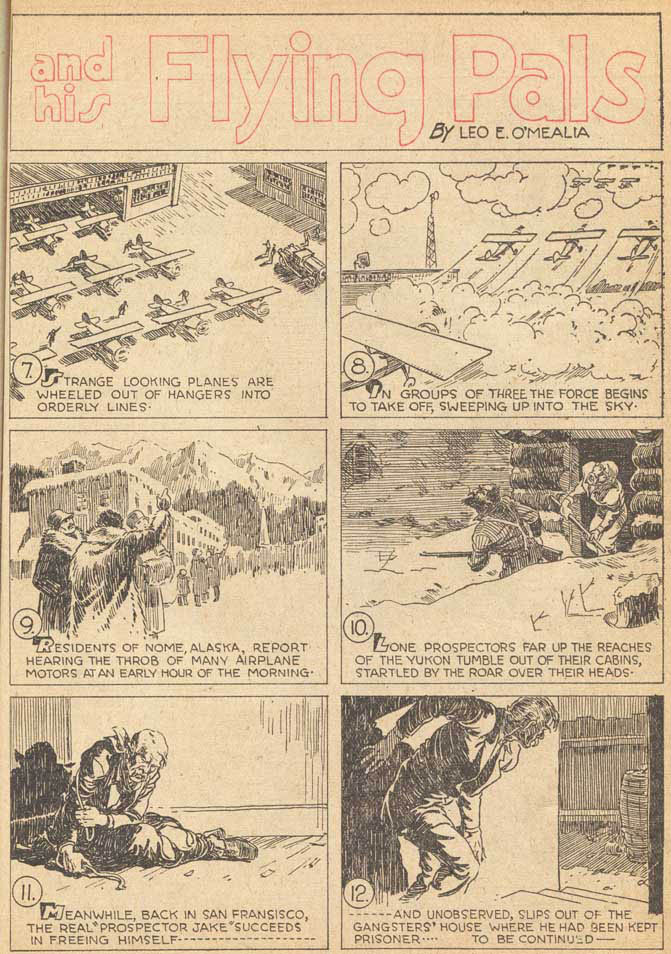
O’Mealia is listed as working through the Chesler Studio in GCD. I have a lot of questions about these designations. There is no doubt to Jerry Bails’s careful research. My doubt comes in with what he was told by various artists many years later. Just as Aunt Marianne remembered the buttons being Superman buttons, people often don’t remember specifics correctly and get dates wrong after a long period of time. People can have axes to grind and people can inflate their egos in one way or another especially in creative situations.
One reason I have questions about this particular designation is that O’Mealia stayed with the Major throughout the entire process and Clem Gretter, Ken Fitch, and Henry Carl Kiefer, also listed at Chesler Studio, all began with New Fun #1 sometime in late 1934 and hung in for some time. I don’t know if this was due to a good relationship with the artists or with the Chesler Studio. It’s an interesting question. How dependent was Harry Chesler on the Major’s comics for work for the artists in his studio? Were there other outlets such as newspapers, advertising or other? Were these artists independent in 1934, 1935 and then signed up with Chesler later? And why? Many of the continuing creators with the Major were not in any of the studios. What made the difference? A regular paycheck? Were they also working independently for the Major? The Major’s comics were the only ones on the newsstands in 1935 until March 1936 that were taking original work until Cook and Mahon started their comic magazine. Wikipedia states that “In 1935 or 1936, Chesler established a studio in Manhattan to supply comic-book content to publishers testing the waters of the emerging medium.” When did he start his studio—1935 or 1936? And who were the publishers testing the waters? Answer—absolutely no one but the Major until Cook and Mahon. No one, so why not say that it was the Major explicitly instead of the vague publishers? Jerry Bails and Hames Ware did the original research into the studios and “shops” followed by others such as Jon Berk and Robert C. Harvey. It’s an important piece of this era of early comics worth pursuing.
Gretta’s (Gretter) “Don Drake on the Planet Saro” continues with two pages in color. There is no byline for either Clem Gretta or Ken Fitch but there is a Gretta signature. Don is fighting the monster while Kremon the Captain of the Guards prepares to shoot him with a cannon. The shot hits the sea beast while Betty struggles with the Zetrurian priests. We see Don climbing up the parapet. It’s not quite clear what is happening and the dialogue doesn’t help. Kremon tries to cut the rope. The rider of the winged death arrives to help but Betty loses her hold on the rope and Don falls into the sea.
Fitch and Gretta’s “2023 Super Police” continues with two pages in color. There is no signature as far as I can tell. We are relieved to discover that Rex and Axel are not dead. They have ended up on a ledge due to a huge wind that has broken their fall. They leave the guard to his own devices and head to a cave. They follow the cave till they reach a stream and find a boat. Rex lights a torch and suddenly something terrible happens. This story is really difficult to follow but it’s interesting and I love the artwork that appears to have an attitude.
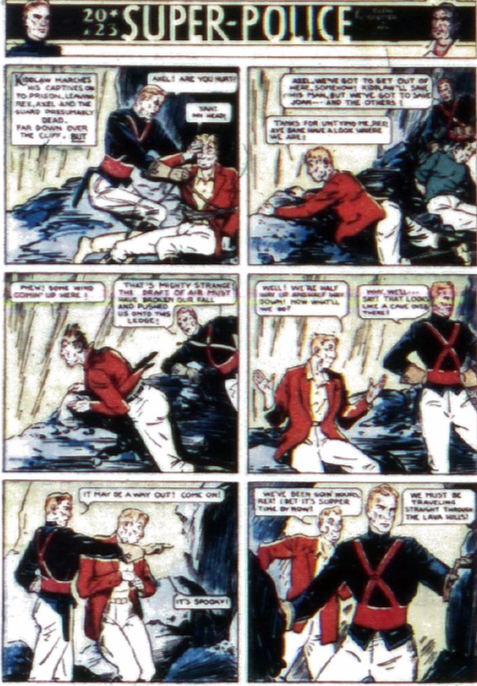
“Henri Duval” by Siegel and Shuster continues with one page in color. The King is captured but Henri is still out of the room. He jumps on one of the guards and exchanges clothes with him. In disguise he gives an order to the men to search the Inn and escapes with the King and the woman (?) while the musketeers are in pursuit. The dialogue and story are a little stilted but the action is great and the artwork is excellent.

Siegel and Shuster also continue “Doctor Occult” as Leger and Reuths with one page in color. This story gets a little confusing. The vampire master apparently makes duplicates of himself and others but the duplicates have no soul. He intends to keep Mrs. Amster as his queen but the duplicate Mrs. Amster stabs him causing him to destroy the building. Somehow the Amsters and Dr. Occult survive. As always Joe Shuster’s artwork is great.
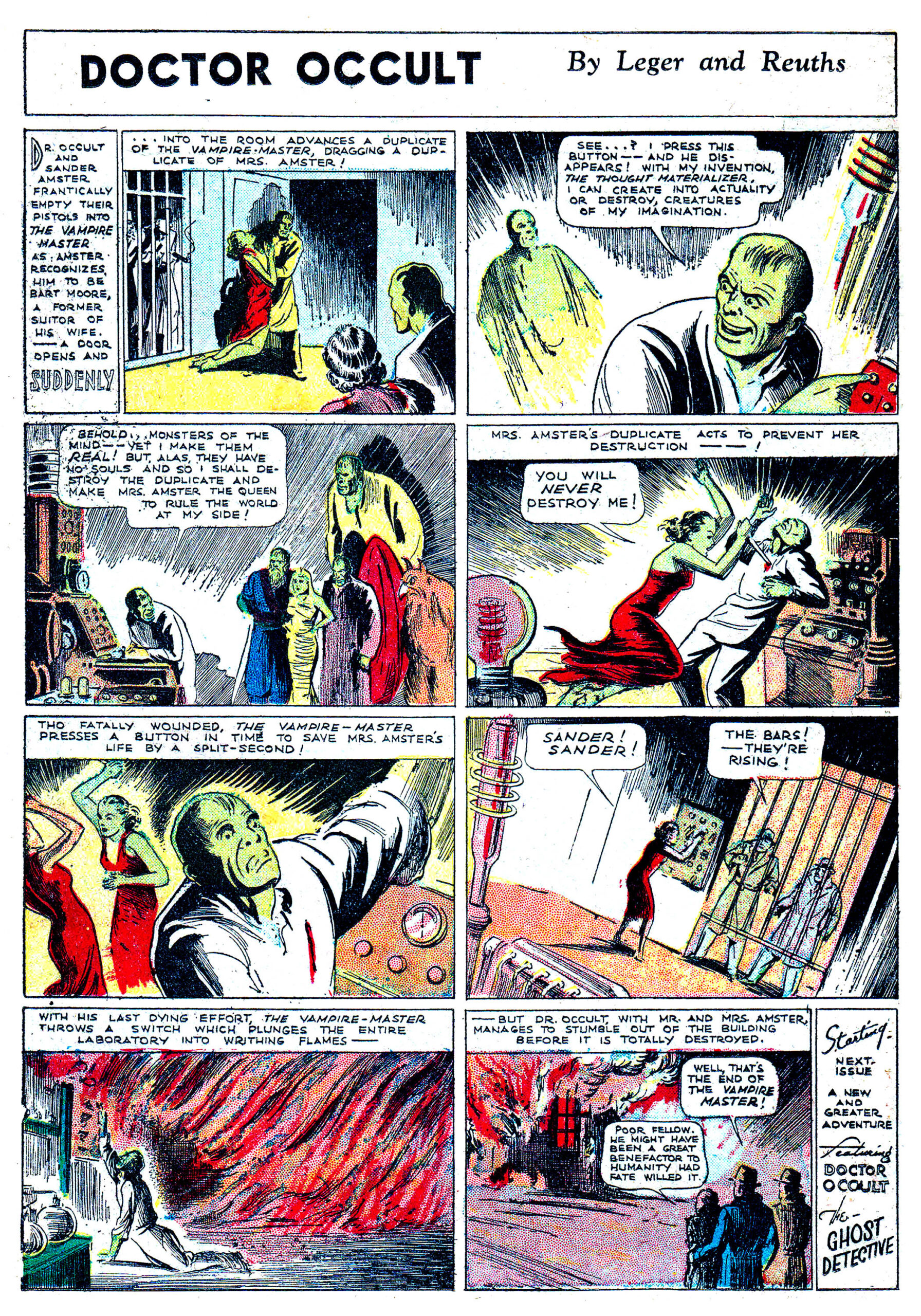
“Slim Pickins” by Stan Randall continues with two pages in black and white and the title in red. Slim leaves the gorilla sleeping under a tree and sneaks away. He buys a newspaper and tries to find a job. The ape returns and Slim pushes him into a pond. The newspaper boy tells him there’s a reward for the gorilla so Slim jumps into the pond to save the gorilla. The artwork is solid and the story although silly is clear. Randall’s “Rambling Jim” appears again in New Comics #4.
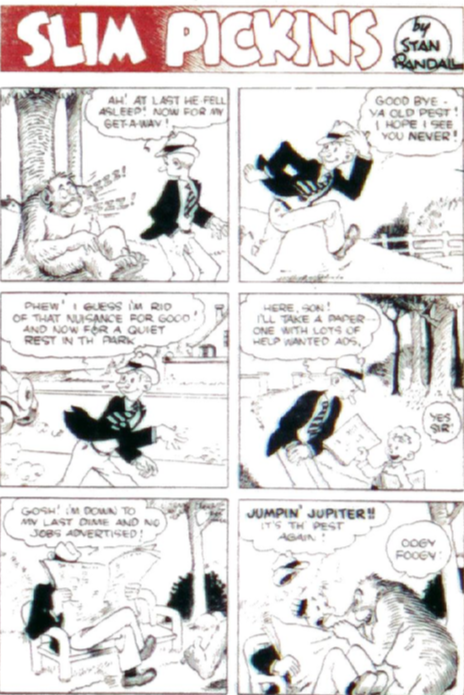
“Treasure Island” continues with two pages in black and white. There is no byline but there is a Sven Elven signature. The story line may be crafted by MWN. The artwork is good and the story well told. The comic is done in classic style with the words at the bottom of the panel and no dialogue. In this episode the Squire buys the Hispanola and hires a crew. Jim packs and goes to Bristol to set sail for Treasure Island.

Al Stahl continues the adventures of “Pelion and Ossa” Animal Antics with two pages in black and white and a red title. Pelion and Ossa hitch their sled to a car to get a free ride. A policeman stops them and starts to untie the sled but the car takes off. The policeman goes on a wild ride and the chief catches him and admonishes him with the same speech the policeman gave Pelion and Ossa. The police characters are human and don’t seem to notice that the “kids” are animals.
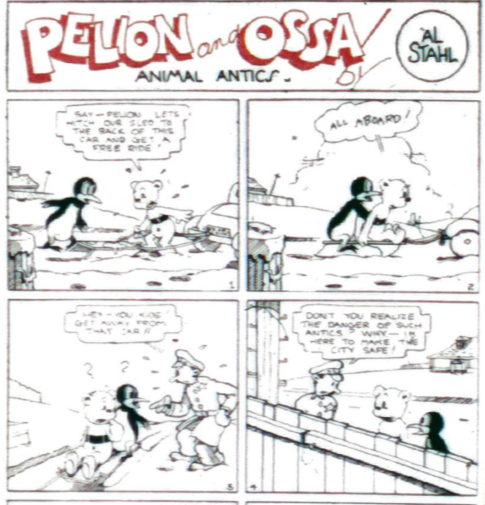
When I first began researching over twenty years ago, I had not seen any of the comics only lists of the comics with creators’ names. I assumed Pelion and Ossa was one of the Major’s classical educational comics as Pelion and Ossa are mountains in Greece and figure in Greek mythology. Since the comic changed hands a number of times, it does make me wonder if MWN had anything to do with the creation. It may well have been one of those collaborative ideas.
“Wing Brady” by Henry Kiefer continues with two pages in black and white. Wing gallops across the desert to save the young American woman who has been captured. He finds the caravan and an old man tells him where they have gone. Wing continues across the desert without any water. His horse finally drops and he wanders in the desert hallucinating. This is an interesting rather noir story. Since Kiefer is listed as the artist by Bails but not as the writer, I wonder if the writer might have been Aline De Kerosett, Kiefer’s wife who collaborated with him on other features.
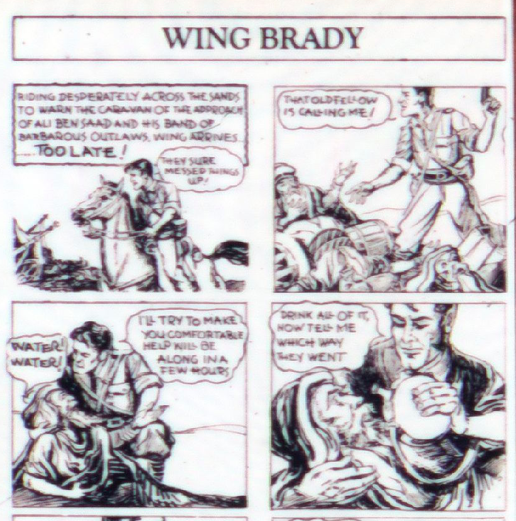
“The Professor” by E.J. Koscik continues on two pages in black and white. The professor decides he needs a zoptaurus and has to go to Africa to find one. He cables his brother who is wealthy and the brother arrives. They book a ship and the two detectives come along. However, the gang has hired on as crew. This story is more interesting than the others and not as silly. The drawing style is quirky and illustrates the characters well. However, this was Koscik’s last contribution so we don’t find out what happens. A version of the story appeared in Funny Picture Stories June 1937 as Professor Joshwink in a quest for the Zozosaurus.
E.F. Koscik (Eugene J.) So far I haven’t been able to turn up any information about E.F. Koscik. He seems to be active in comics in 1936-1937 and then disappears. He’s on the mystery list.
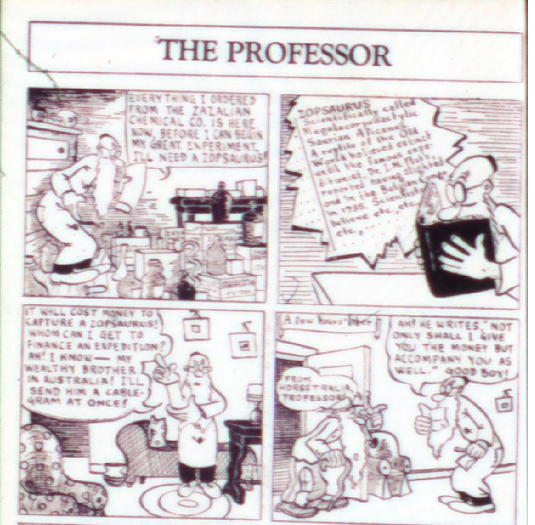
The regular feature “Fun Mail” is one page with a drawing by 14-year-old K. (Kenneth) Bald that is quite good. One reader wants the first issue of Fun but is told there aren’t any more issues. That’s an interesting remark, if true. From the letters it is obvious that girls as well as boys are reading the comics. There is a small inset box explaining the mix-up of pages for the “Bobby and Scotty” and “Woozy Watts.” How would something like that have occurred? It’s another indication to me that the Major was not as involved with this issue.

There are two additional regular features about movies and books but the regular features “Stamps and Coins” and “More Fun and Magic” are absent. There is no “Junior Funsters,” no “Learn to be a Cartoonist” and since Matt Curzon has departed for Cook and Mahon’s new comics magazine no “Puzzle Page.” It looks as if there is a reshuffling of content since some of these features are duplicated in New Comics. We’ll see how that plays out in More Fun #10.
“Talk about Talkies” an article by Mary Patrick takes up one page. There is no article on Radio programs. Patrick reveals the unique details of “Follow the Fleet” with Fred Astaire and Ginger Rogers and a full-page photo of the two of them is on the next page. There are some great anecdotes about Myrna Loy obviously from a publicist and two blurbs of upcoming films—”The Story of Louis Pasteur” with Paul Muni and “Under Two Flags” with Claudette Colbert, Ronald Coleman and Victor McLaglen. It’s interesting to read about how these films were marketed and perceived during their own period.
“Books Books,” a regular feature, is by Edith Brittin on one page with the original title illustration by Dick Loederer in red. Several books are discussed including one called “Nicodemus and His Gran’pappy” by Inez Hogan. The description is interesting in that the child is described as black. “…about this little black boy who gets in so much trouble and gives readers so much to laugh about.” It is noted that “Sometimes it’s hard to understand some of the colored dialect—but once it’s understood it’s enough to make you split your sides.” I did some cursory research and Inez Hogan (1895-1973) was white. She wrote 63 books for children, many of them animal tales. Unfortunately, it seems that the black characters in her books were portrayed in stereotypical fashion.
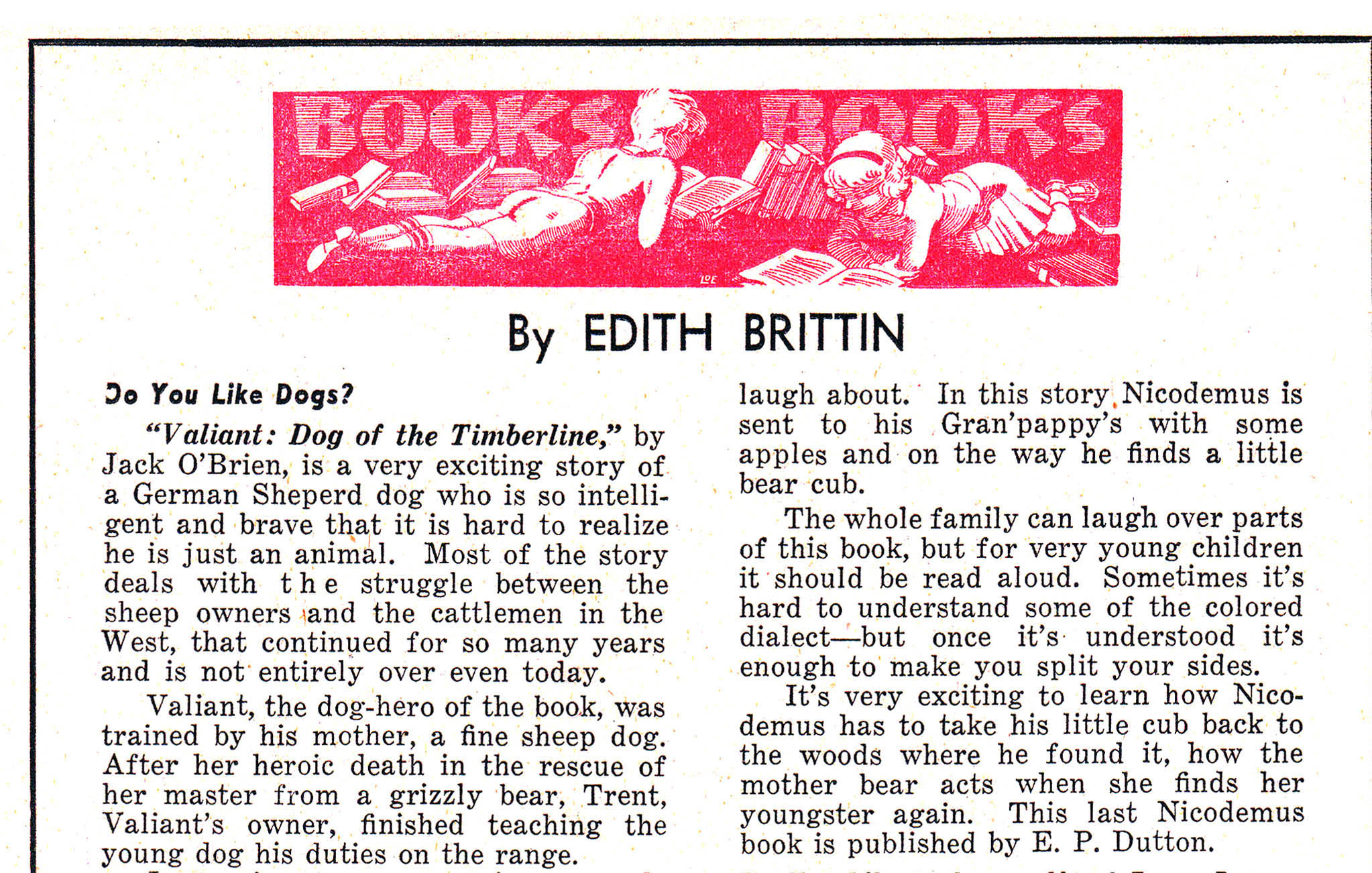
Two continuing comics were taken over by new contributors.
A Leslie Ross, known for his pulp illustrations took over “Brad Hardy” with two pages in black and white. Richard Loederer began the story in New Fun #3 with W. C. Brigham, Jr. taking over in New Fun #6 continuing through More Fun #7 and 8. I would guess from the way Brigham handled the series he wasn’t sorry to let it go. The story is better but it’s still confusing. The artwork is more refined as well. In this sequence the ape men chase Brad and the group. He manages to hold them off but then the Ape god comes alive in the last panel. With these continuing stories that change hands, especially those that have elements from the Major’s pulps, I wouldn’t be surprised if this comic was an idea he came up with turning it over to others to illustrate.
Harlan (Harlan David Haskins) took over “The Magic Crystal of History” with two pages in color. The artwork is attractive with desert scenes and the story is told more poetically in the classic style with dialogue and narration at the bottom of the panel. Bobby and Binks are still in Egypt and captive. During the fight they manage to escape and head into the desert.
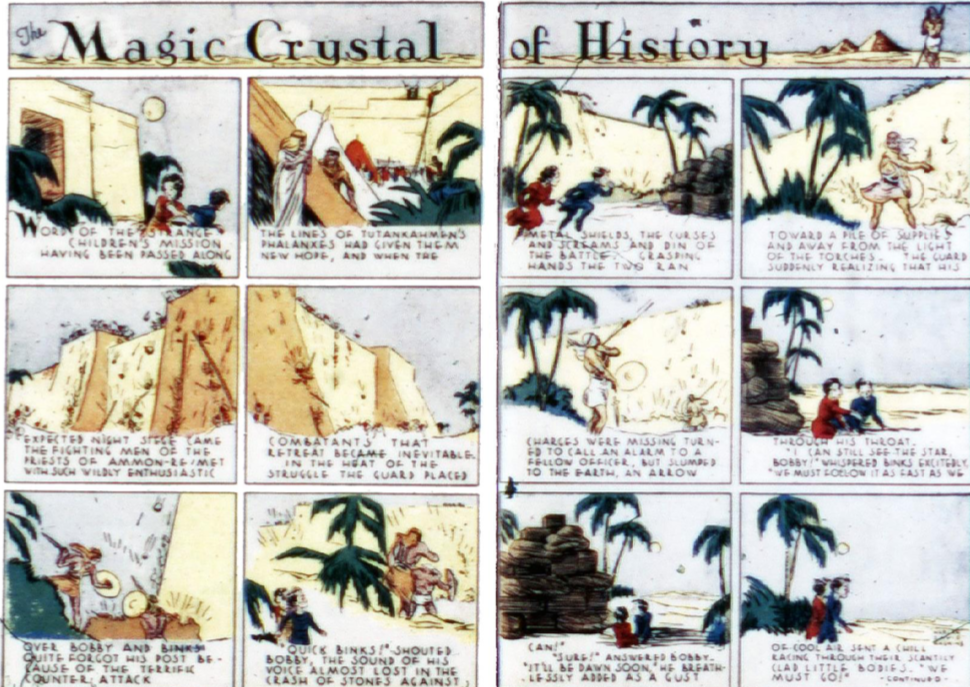
Several new contributors appear with new comics.
“Bobby and Scotty” by Harry Lewis has two pages in color. This is one of the comics where the pages were not in order. It’s drawn in art deco 20’s style with almost no dialogue. The younger brother doesn’t like his sister’s boyfriend and sends the dog in with the boyfriend’s hat and cane indicating he should leave. As he leaves he trips from the rug the brother has put on the stairs. The girl runs to comfort him and they end up in the same embrace as at the beginning. Lewis was active beginning in 1909 so it’s not surprising his art would be in a deco style. I love the look but would it have seemed dated at this point?
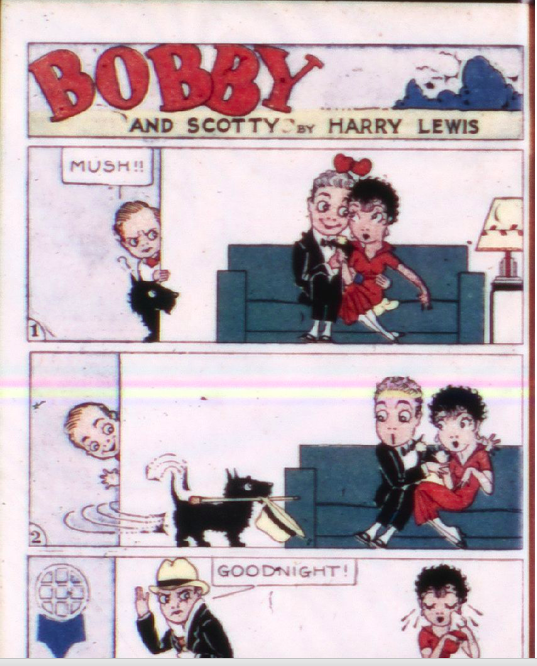
Harold Sherman contributed two comics, “Chubby,” one page in color. It’s an odd comic with unlikeable angry characters. Chubby as the main character seems rather pathetic.
“Rusty” also by Harold Sherman is two pages in color. It’s another angry people comic with angry guy yelling at a kid. The kid takes his dad’s car and ends up ramming it into someone else’s car. The kid who is Rusty—I guess—explains he has no brakes. The guy takes his car to to the city dump. The story isn’t all that clear and it isn’t that funny. The artwork is somewhat unusual and painterly.
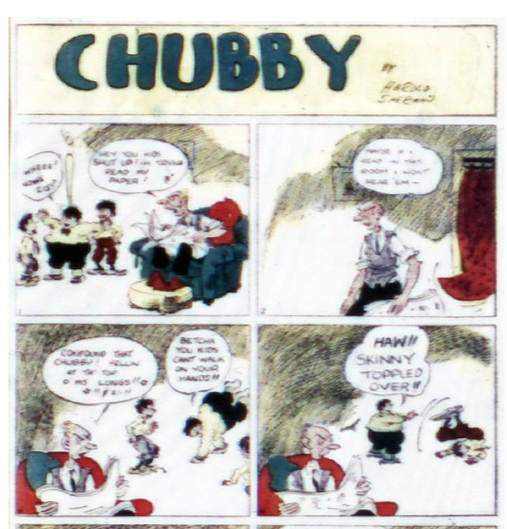
“Woozy Watts” is the second of the two comics where the pages were out of order. It’s two pages in color by Russell Alger Cole as Alger. It’s a classic Depression era comic with Woozy wearing a sandwich board advertising a cheap dinner at Mike’s. Joe helps him with his sign and paints a free dinner at Mike’s on the back unbeknownst to Woozy. Chaos ensues. The story is clear, characters are likeable and nice artwork typical of the era.
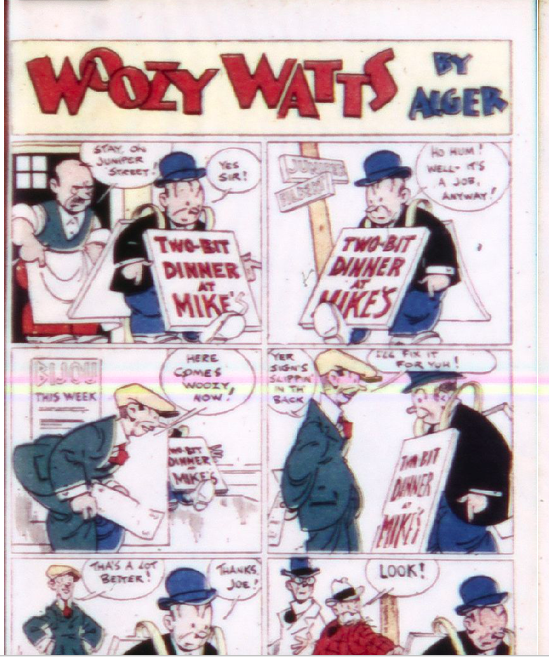
“Hubert” by J. Muselli and Bill Patrick appears for the first time with two pages in color. It’s an unusual comic, almost surrealistic. There is no dialogue. Hubert, a sort of British Buster Keaton type sees a box of magnets fall off a truck. He puts them in his pockets and when he passes by a construction area with a huge steel beam it picks him up. The character is interesting and the artwork is well-done and clear with strong lines.
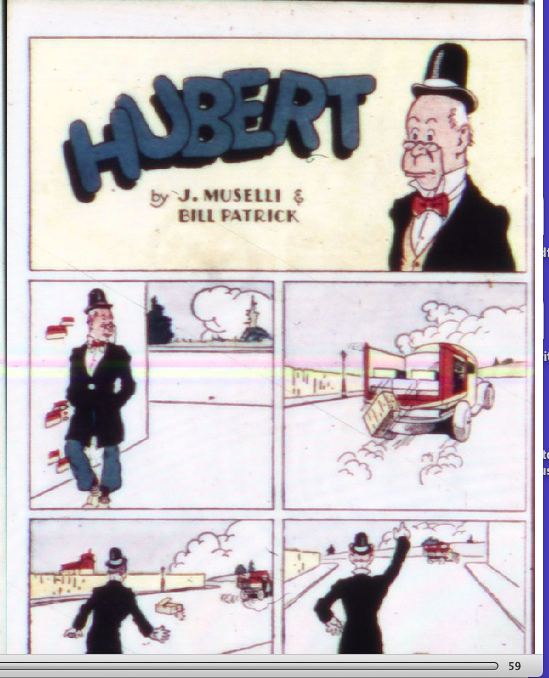
And for the first time Creig Flessel as Fless appears with a two-page splash, in black and white with a red border, “Presenting Acorn Antics.” It’s too bad I don’t have a better image as this is an intricate drawing with various elves in a tree. There is sly humor in the sign, “Members of Acornville Chamber of Commerce.” Flessel’s playful side is apparent and he is clearly a skillful artist. All the faces and there are a lot, have different expressions. It’s going to be fun to see his art develop over the next issues.
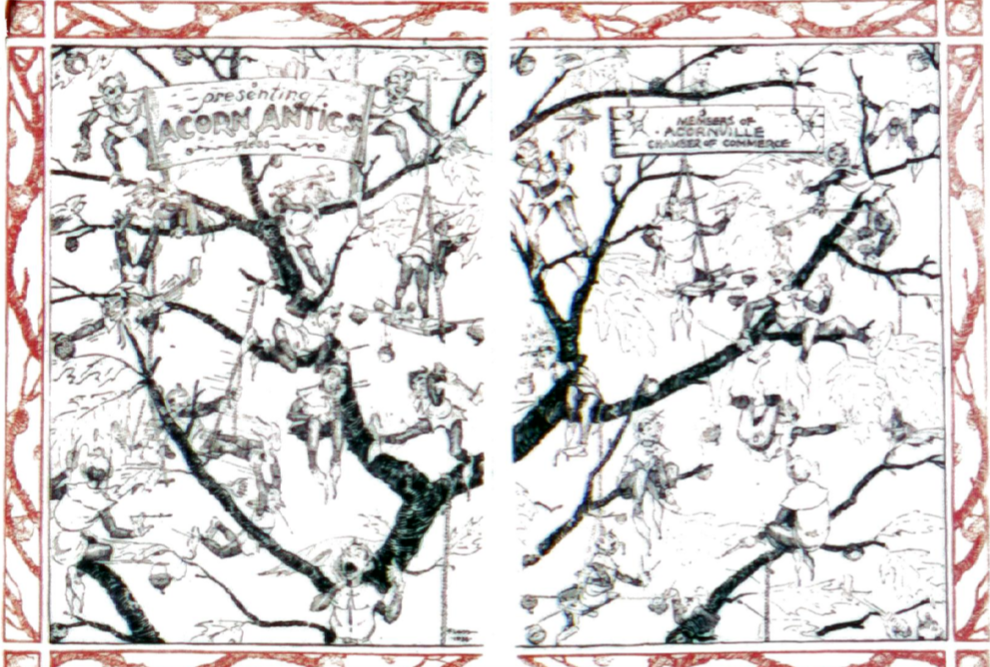
More Fun #9 feels somewhat rushed and overall, the sense is that things are shifting. Sullivan and Ellsworth are taking on more responsibilities and it’s more than likely there are financial problems. To make things more interesting in the midst of juggling money, creators, printers, distributors, advertisers, etc. during the Depression, now the Major has competition. Let’s see how it goes in the next post on New Comics #4 with a look at the rival comic from Cook and Mahon.
Thanks to Jerry Bails, Bob Cherry, Doc DC, ComicBooks Plus, Grand Comics Database and Lambiek Comiclopedia.
